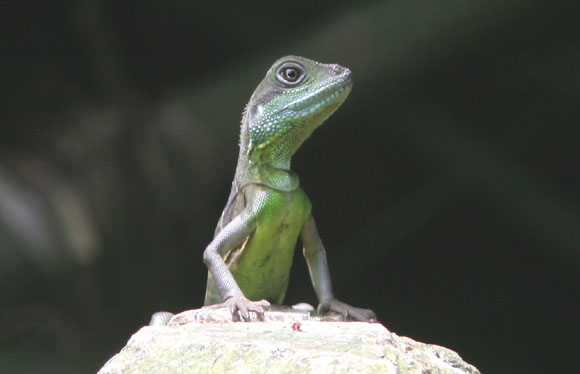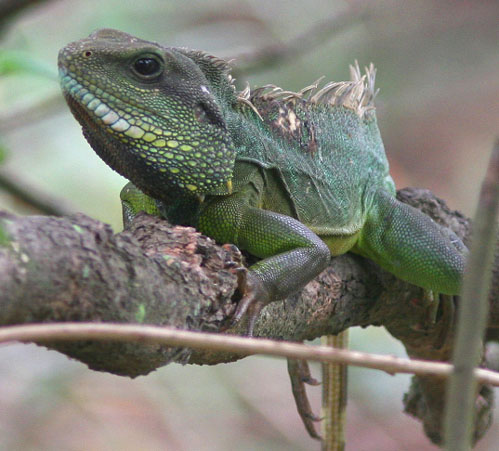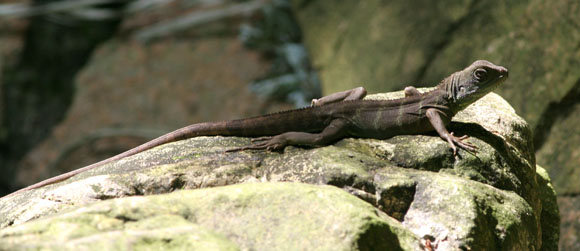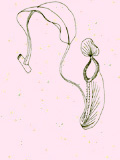
 |
Vertebrates (pdf)
|
Enormous fishing pressure on the whale sharks Rhincodon typus in Taiwan and southern China waters |
|
|
First sighting of the pearlscale butterflyfish in eastern Hong Kong waters |
|
Another alien has landed: the discovery of a wild population of water dragon, Physignathus cocincinus, in Hong Kong (pdf)
by Allen To
An apparently wild population of the water dragon, Physignathus cocincinus, has been discovered along a stream on Tsing Yi Island, New Territories, which runs adjacent to two housing estates. The stream has two sections, the lower section is about 30 m long with large boulders and has a wetted width of about 1 m, covered with riparian shrubs. The upper section is about 50 m long and is more densely vegetated than the first section. There are some agricultural activities along the upper section.
I am living in the housing estate next to said stream. Since water dragons were discovered there in October 2004, I have visited the stream on a bi-weekly basis. So far, at least eight individual water dragons have been recorded. Three are more than 60 cm long from head to tail; two are about 45 cm long and the last three, juveniles, are about 30 cm long (Fig. 1). The three largest water dragons are likely to be males because of the large size, triangular head and extended mid-sagittal crest (Fig. 2). The other two medium-sized individuals are possibly females (Fig. 3). The water dragons were less active in December 2004 and were not sighted again until April 2005. Hikers using the nearby hiking trail reported sightings of these ‘large lizards’ a few years ago. The water dragons appear to have colonized the whole of the lower section of the stream and along to the middle part of the upper section. They were observed utilizing boulders as basking spots, and the stream and tall trees as resting sites (or maybe as a sentry box for defending territories).
The water dragon, is semi-aquatic and is distributed in China, Thailand and Vietnam (Lau, 1995; Zhao & Adler, 1993). There is no known previous record of this lizard in the wild in Hong Kong (Bogadek & Lau, 1997; Karsen et al., 1998). However, it is commonly available in local reptile pet shops for sale (Lau et al., 1997). Thus, it is very likely that these water dragons were released by people who used to keep them at home as pets. If this population in Tsing Yi is breeding successfully and expanding, it becomes an additional naturalized exotic species in Hong Kong. However, it does not appear on the IUCN Global Invasive Species Database and is therefore not considered invasive anywhere in the world. [1]
 |
|
Fig. 1. The smallest juvenile (~ 30 cm long) (Photo: Allen To). |
 |
|
Fig.2. An adult male (> 60 cm from head to tail) resting on a branch (Photo: Allen To). |
 |
|
Fig. 3. Medium sized female (~ 45 cm long) (Photo: Allen To). |
Bibliography
[1] http://www.issg.org/database/welcome/
Bogadek, A. & Lau, M.W.N. (1997). A revised checklist of Hong Kong amphibians and reptiles. Memoirs of the Hong Kong Natural History Society 21: 173–188.
Karsen, S.J., Lau, M.W.N.& Bogadek, A. (1998). Hong Kong Amphibians and Reptiles. The Provisional Urban Council, Hong Kong SAR. 186pp.
Lau, M.W.N., Ades, G., Goodyer, N. & Zou, F.S. (1997). Wildlife Trade in Southern China including Hong Kong and Macau. In: Conserving China's Biodiversity (John MacKinnon, WANG Sung eds.), China Environmental Science Press, Beijing: 141-159.
Lau M. (1995). 專題報告: 中國南部野生動物貿易調查報告 Available from <http://www.wwfchina.org/csis/shwdyx/technical report/10.htm> [Accessed 4 July 2005].
Zhao, E.M. & Adler, K. (1993). Herpetology of China. Society for the Study of Amphibians and Reptiles in cooperation with Chinese Society for the Study of Amphibians and Reptiles. Oxford, Ohio, USA. 522pp.
| P.3-4 |
|
Porcupine! |
 Copyright © 2000 |
